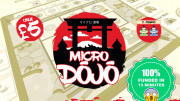Buurn (Morning) – At the start of each round, ingredient cards and one organization card are placed face-up on the table. The active player then starts counting down from the number currently shown on the back of the organization deck. The first player to snatch the purchase totem from the player mat, pays an amount equal to the last number said in the countdown and gets the ingredient cards drawn that round. The amount paid is distributed evenly among the other players. Any amount that cannot be divided evenly is placed in the bank. Once the purchase totem is grabbed, the other players must grab for the remaining totems. The taxes totem allows you to earn extra money from the amount paid for the ingredients, one totem allows you to take that round's organization card which has some type of ability, while the black market totem allows you to either take all the money from the bank or pay five dollars to draw two ingredient cards from the deck and choose one.
Casual Games on Kickstarter: Buurn, Chai, and CATastrophe

This month on Kickstarter there are games of speed and spice, two player duels in the dojo or in the tea fields, and lots and lots of cats!
Chai: Tea for 2 (Steeped Games) – During the first phase of each round, the first player moves the tea assistant forward one-to-three tiles, and both players take tokens shown on the tile the assistant ends on. You also receive a certain number of benefits which allow you to take more tea tokens and/or move a token on your plantation board. During the next phase, both players roll their dice, and then place their dice on the main board. Some spaces allow you to earn extra tokens, move cards around your plantation board, or take a plantation card and place it around your plantation board, applying its effect based on the section you play it to. There are some actions on the main board that require more than one die to activate — these resolve at the end of the round, rather than when you place your dice, and you can outbid your opponent by using more dice or higher valued ones. During the round, you can discard a tea token from your plantation board in order to change the value of a die.
CATastrophe (The Original Sasquatch) – At the start of your turn you may play any number of cards from your hand. There are four types of cards: attack and curiosity cards which can cause another player to lose a life, reaction cards which are played in response to an opponent's card, and ally cards which have a range of abilities. You then draw three cards and add them to your hand. Finally, you reveal the top card of the catastrophe deck and follow its instructions. These have a large range of effects or mini games that players must complete and can cause you to lose lives. For example, one card has each player tossing a die towards the card from the edge of the table, and the player whose die lands the farthest away loses a life. When a 'grim reapurr' card is drawn, his token his moved one space up on the life tracker. A player is eliminated from the game if he is ever on the same space as the grim reapurr, but you are also eliminated if you run out of all your nine lives. The last player standing is the winner.
Micro Dojo (Prometheus Game Labs) – The board, which shows a three-by-three grid, is placed on the table and the four meeples are placed in the corner spaces. Six buildings are then randomly selected to be in the game, as are five objectives which are randomly assigned point values which also determine the order in which they will be scored during the game. On your turn you may move a meeple to an adjacent space on the grid and then perform that space's ability. This ability may be to earn resources or coin, purchase a building, or take an action. Actions include, for example, activating the ability of a building you own, turning resources in for points, or scoring the next objective. After you resolve the space, you place your token on the meeple you moved. That meeple cannot be moved again until your token is moved on a future turn.
Intel (John, Ethan, Alex) – Your objective is to find and track the agent card. At the start of the game it will start in a random player's hand. Player then take turns playing cards. Some cards cause the agent to move between players or allow you to randomly steal a card from another player or look at another player's hand. At the end of the round, players vote on who they believe is holding the agent card. The fewer people who vote correctly, the more points you get for voting correctly. If you have the agent you also get more points when fewer people guess that you are holding the card, while it is worth no points at all if everyone guesses that you are the one holding it. There are also point cards which are worth points if still in your hand at the end of the game and a double agent which is worth points if players incorrectly guess that you have the agent.
Vivid Memories (Floodgate Games) – The game is played over three rounds and each round follows four phases. During the first phase, moment tiles are drawn equal to the number of players plus two and laid out in a line, then five memory fragments are drawn and placed on each one. During the remember phase, players take turns drafting fragments, starting at either end of the moment line. You may take one to three, but if you take two they must be the same color fragment and if you take three they must be all different colors. If you empty a moment tile of fragments, you move the tile to a space above your board. After you draft your fragments you then place them on your brain board, placing them all in a single empty hex space. If you only took one fragment token, this allows you to move fragments that are already on your board. Players continue to take turns drafting fragment tokens until they have all been taken from the moment line. You then move onto the reflect phase where players can perform actions from their moment tiles, while in the fourth phase players score points based on connections made with matching fragments, and matching patterns shown on moment tiles.
Disclosure: unless otherwise noted, we have not seen or played any of the above games. Our assessment of each is based on the information given on the crowdfunding project page.










